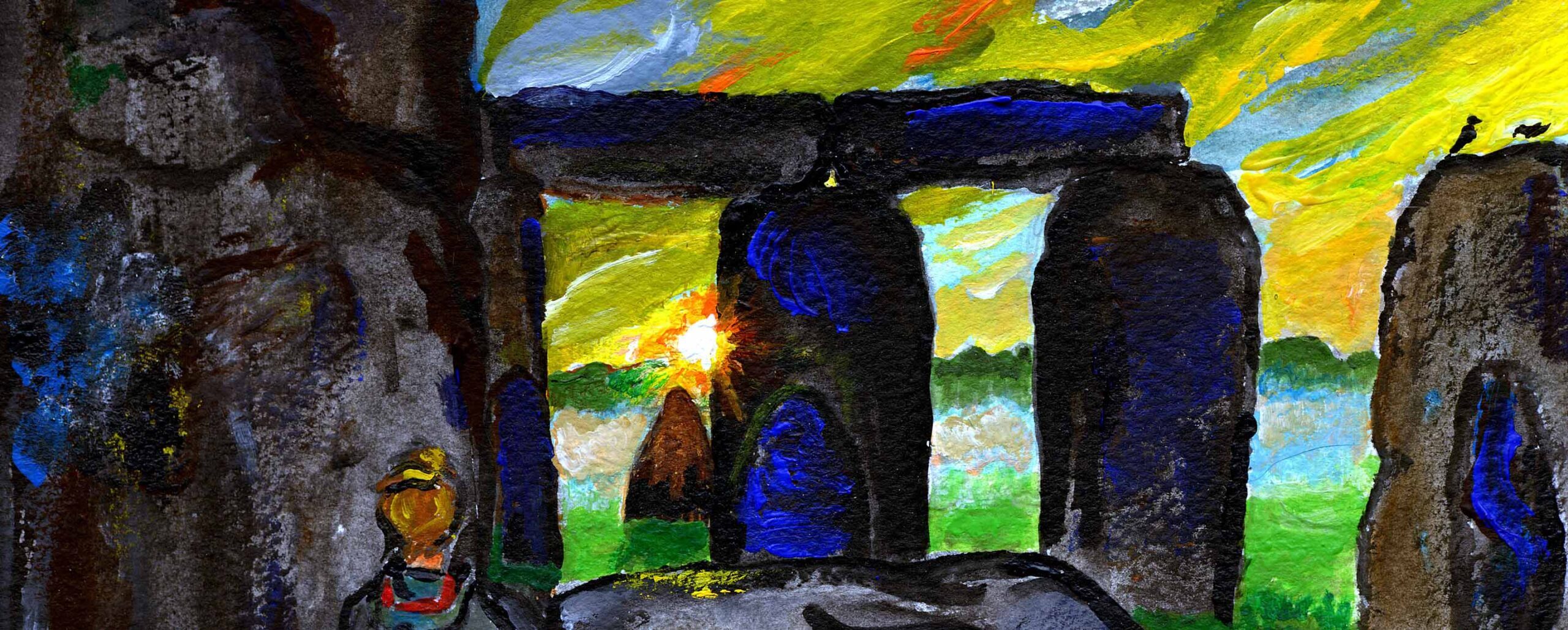Saturn, Antares, the First-Quarter Moon, Jupiter, Spica, and Venus – spread across the after-sunset sky.

You may be able to enlarge this image by right-clicking on it.
Venus on August 18 is at greatest eastward elongation, its greatest angular distance from the Sun. But Venus is rather low in our north-hemisphere sky because it has since August 1 moved south of the ecliptic, which itself is at a low late-summer angle to the horizon.
In our diagram, the Moon is exaggerated twice in size but Venus and Saturn 150 times, to show their shapes in the telescope. Like the Moon, Venus appears D-shaped because of its angle to the Sun. Its actual moment of geometrical “dichotomy” – cutting into halves – was on August 15, but its cloudy surface causes it to look that way earlier. The Moon was at First Quarter today as it passed the point we mark as the “antapex of Earth’s Way”, the direction backward along our orbit: it is crossing behind us.
The Moon and Venus show their reflective half-faces because they are in the foreground of this array; greatly farther off are the two giant planets, and grossly farther off, the supergiant stars.

Great post and great illustrations too. Cheers
What is the blue inverted U shape southwest of Spica? I assume it’s a measurement artifact but at about 2 degrees in length I can’t imagine what use it would have.
A small inverted Y-shape, rather, with two stars? It’s part of the constellation Corvus, the rest of which is below the horizon.
In horizon scenes of this sort, I’ve recently been opting to leave all the constellation form-lines showing, though deleting the names of those not close to the action being talked about.
You could give your opinion(s) on this option as compared with the usually more simplified horizon scenes in, for instance, Sky & Telescope/
I see a blue inverted U that is much nearer to Spica than the stars in Corvus. Maybe it doesn’t show up on your copy of the post.
Ah, I understand! It’s an accidental artefact. Technical explanation required, for those who would like to understand.
The illustration starts as an .eps file, created by my program and opened in Adobe Illustrator. There, I edit it by moving and deleting labels etc., manage its size on the screen (300% seems to be a good default), then press the “print screen” key, open the resulting image in Adobe Photoshop, crop it, and save it as a ,jpg image.
Before the step of pressing “print screen”, I should make sure that nothing is visibly selected. For instance, if I happen to have selected a label so as to move it, it will show an underline. In this instance, I didn’t notice that my cursor had accidentally clicked on one of the thousands of small rectangles of which the sky background is made. I should have ended with one of the deletings, or clicked a spot well out to the side, which was going to be cropped.
So the blue marks around the selection show only in the final .jpg picture, thus in the post, but not in the source .eps image if I re-open that.
The sky background consists of thousands of little rectangles so that the illumination can be calculated for each of them – including sky glow, moon glow, and Milky Way glow – to give the graded effect.
Thanks. I hadn’t noticed the moon glow in your diagrams. I also learned of the term “sky glow” though of course I have observed that the darkest sky is overhead because there’s less atmosphere to reflect light when viewing the zenith.
Hope this comes through. This is my view.
/Users/rickscheithauer/Desktop/ho180818ev.jpg
Hi Guy! I love this sentence: “The Moon was at First Quarter today as it passed the point we mark as the “antapex of Earth’s Way”, the direction backward along our orbit: it is crossing behind us.”
I’ve written an article about this crossing as well as the other earth orbit crossing when the Moon is leading us.
https://starinastar.com/moon-teaches-see-earths-orbit/
Thank you for the insights! I am continually inspired by the many celestial arrangements you point out!
Hello, Guy
You can also grab the image, if you are on a Mac, put it on your desktop, open it, and enter full screen mode.
Joseph
I hope the clouds clear in NC so I can see this, but the weather isn’t looking good. July was hopeless for astronomy here and I’m beginning to worry I won’t get any images of Mars for this opposition.
I hope you get clear skies and a good picture. Will there be any consolation in looking at other people’s pictures?